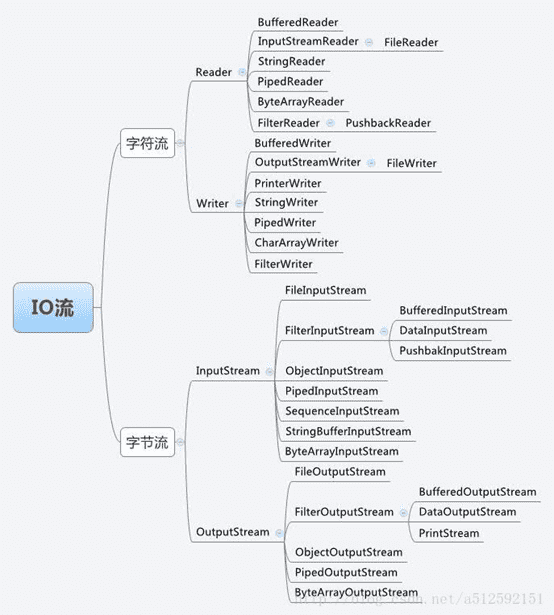TIP
本文主要是介绍 源码解析-Java IO包 。
# Java源码解析—Java IO包
# 一、基础知识:
Java IO一般包含两个部分:1)java.io包中阻塞型IO;2)java.nio包中的非阻塞型IO,通常称为New IO。这里只考虑到java.io包中堵塞型IO;
Java.io包简单地分类。
2.1 Java的IO主要包含三个部分:
1)流式部分――IO的主体部分;
2)非流式部分――主要包含一些辅助流式部分的类,如:File类、RandomAccessFile类和FileDescriptor等类;
3)文件读取部分的与安全相关的类,如:SerializablePermission类。以及与本地操作系统相关的文件系统的类,如:FileSystem类和Win32FileSystem类和WinNTFileSystem类。
2.2 流式部分可以概括:
1)字节流(Byte Stream)和字符流(Char Stream)的对应;
2)输入和输出的对应。
3)从字节流到字符流的桥梁。对应于输入和输出为InputStreamReader和OutputStreamWriter。
2.3 流的具体类中又可以具体分为:
1)介质流(Media Stream或者称为原始流Raw Stream)――主要指一些基本的流,他们主要是从具体的介质上,如:文件、内存缓冲区(Byte数组、Char数组、StringBuffer对象)等,读取数据;
2)过滤流(Filter Stream)――主要指所有FilterInputStream/FilterOutputStream和FilterReader/FilterWriter的子类,主要是对其包装的类进行某些特定的处理,如:缓存等。
2.4 节点流和处理流
1)节点流是FileInputStream、ByteArrayInputStream这些直接从某个地方获取流的类;
2)处理流则是BufferedInputStream这种可以装饰节点流,来实现特定功能的类。因此,节点流可以理解为装饰者模式中的被装饰者,处理流则是装饰者。
类图可以参考博客: https://blog.csdn.net/u013063153/article/category/6399747

# 二、类的分析
# 1、输入字节流
IO中输入字节流的继承图:
-InputStream
-ByteArrayInputStream //将内存中的Byte数组适配为一个InputStream
-FileInputStream //最基本的文件输入流。主要用于从文件中读取信息
-FilterInputStream //给其它被装饰对象提供额外功能的抽象类
-BufferedInputStream //使用该对象阻止每次读取一个字节都会频繁操作IO。将字节读取一个缓存区,从缓存区读取。
-DataInputStream //使用它可以读出基本数据类型
-LineNumberInputStream //跟踪输入流中的行号。可以得到和设置行号。
-PushbackInputStream //可以在读取最后一个byte 后将其放回到缓存中。
-ObjectInputStream
-PipedInputStream //在流中实现了管道的概念读取PipedOutputStream写入的数据。
-SequenceInputStream //将2个或者多个InputStream 对象转变为一个InputStream
-StringBufferInputStream //将内存中的字符串适配为一个InputStream(废弃)
1)InputStream是抽象类,是所有字节输入流的超类。
2)ByteArrayInputStream、StringBufferInputStream、FileInputStream是三种基本的介质流,它们分别将Byte数组、StringBuffer、和本地文件中读取数据。PipedInputStream是从与其它线程共用的管道中读取数据;
3)ObjectInputStream和所有FilterInputStream的子类都是装饰流(装饰器模式的主角)。
4)FileInputStream 文件输入流,用于读取本地文件中的字节数据。
# 2. IO中的输出字节流
IO中输出字节流的继承图:
-OutputStream
-ByteArrayOutputStream //在内存中创建一个buffer。所有写入此流中的数据都被放入到此buffer中。
-FileOutputStream //将信息写入文件中。
-FilterOutputStream //实现OutputStream装饰器功能的抽象类。
-BufferedOutputStream //使用该对象阻止每次读取一个字节都会频繁操作IO。将字节读取一个缓存区,从缓存区读取。
-DataOutputStream //使用它可以写入基本数据类型。
-PrintStream //产生具有格式的输出信息。(一般地在java程序中DataOutputStream用于数据的存储,即J2EE中持久层完成的功能,PrintStream完成显示的功能,类似于J2EE中表现层的功能)
-BufferedOutputStream //使用它可以避免频繁地向IO写入数据,数据一般都写入一个缓存区,在调用flush方法后会清空缓存、一次完成数据的写入。
-PipedOutputStream //任何写入此对象的信息都被放入对应PipedInputStream 对象的缓存中,从而完成线程的通信,实现了“管道”的概念。
1)OutputStream是所有的输出字节流的父类,它是一个抽象类。
2)ByteArrayOutputStream、FileOutputStream是两种基本的介质流,它们分别向Byte数组、和本地文件中写入数据。PipedOutputStream是向与其它线程共用的管道中写入数据。
3)ObjectOutputStream和所有FilterOutputStream的子类都是装饰流。
# 3. 字节流的输入与输出的对应
1)LineNumberInputStream主要完成从流中读取数据时,会得到相应的行号,至于什么时候分行、在哪里分行是由改类主动确定的,并不是在原始中有这样一个行号。在输出部分没有对应的部分,我们完全可以自己建立一个LineNumberOutputStream,在最初写入时会有一个基准的行号,以后每次遇到换行时会在下一行添加一个行号,看起来也是可以的。
2)PushbackInputStream的功能是查看最后一个字节,不满意就放入缓冲区。主要用在编译器的语法、词法分析部分。输出部分的BufferedOutputStream几乎实现相近的功能。
3)SequenceInputStream可以认为是一个工具类,将两个或者多个输入流当成一个输入流依次读取。完全可以从IO包中去除,还完全不影响IO包的结构,却让其更“纯洁”――纯洁的Decorator模式。
4)PrintStream也可以认为是一个辅助工具。主要可以向其他输出流,或者FileInputStream写入数据,本身内部实现还是带缓冲的。本质上是对其它流的综合运用的一个工具而已。一样可以踢出IO包!System.out和System.out就是PrintStream的实例!
5)ObjectInputStream/ObjectOutputStream和DataInputStream/DataOutputStream主要是要求写对象/数据和读对象/数据的次序要保持一致,否则轻则不能得到正确的数据,重则抛出异常;
6)PipedInputStream/PipedOutputStream在创建时一般就一起创建,调用它们的读写方法时会检查对方是否存在,或者关闭。
# 4. 输入字符流
IO中输入字符流的继承图:
-Reader
-BufferedReader
-LineNumberReader
-CharArrayReader
-FilterReader
-PushbackReader
-InputStreamReader
-FileReader
-PipedReader
-StringReader
1)Reader是所有的输入字符流的父类,它是一个抽象类。
2)CharReader、StringReader是两种基本的介质流,它们分别将Char数组、String中读取数据。PipedReader是从与其它线程共用的管道中读取数据。
3)BufferedReader很明显就是一个装饰器,它和其子类负责装饰其它Reader对象。
4)FilterReader是所有自定义具体装饰流的父类,其子类PushbackReader对Reader对象进行装饰,会增加一个行号。
5)InputStreamReader是字节流向字符流转化的桥梁,它使用指定的 charset 读取字节并将其解码为字符。它使用的字符集可以由名称指定或显式给定,或者可以接受平台默认的字符集。其构造方法的默认参数为InputStream 对象。
使用方法:
InputStreamReader(InputStream in),
InputStreamReader(Inputstreamin, charset cs)
为了达到最高效率,InputStreamReader通常用法为:
BufferedReader in = new BufferedReader(newInputStreamReader(System.in));
BufferedReader:缓冲输入流,包装其他字符输入流,提高读取效率,从字符输入流中读取文本,缓冲各个字符,从而实现字符、数组和行的高效读取。Reader的读取操作开销大,为提高效率使用BufferedReader包装其他Reader(如FileReader和InputStreamReader)
# 5. 输出字符流:
IO中输出字符流的继承图:
-Writer
-BufferedWriter
-CharArrayWriter
-FilterWriter
-OutputStreamWriter
-FileWriter
-PipedWriter
-PrintWriter
-StringWriter
1)Writer是所有的输出字符流的父类,它是一个抽象类。
2)CharArrayWriter、StringWriter是两种基本的介质流,它们分别向Char数组、String中写入数据。PipedWriter是向与其它线程共用的管道中写入数据。
3) BufferedWriter是一个装饰器为Writer提供缓冲功能。
4)PrintWriter和PrintStream极其类似,功能和使用也非常相似。
5)OutputStreamWriter:是字符流通向字节流的桥梁,它使用指定的 charset 读取字符并将其解码为字节。它使用的字符集可以由名称指定或显式给定,或者可以接受平台默认的字符集。
使用方法:
其构造方法的默认参数为OutputStream 对象,
OutputStreamReader(InputStream in),
OutputStreamReader(Inputstream in, charset cs)
为了达到最高效率,OutputStreamReader通常用法为:
BufferedWriter out = new BufferedWriter(newOutputStreamWriter(System.in));
BufferedWriter:缓冲输出流,包装其他字符输出流,提高读取效率,将文本写入字符输出流,缓冲各个字符,从而提供单个字符、数组和字符串的高效写入Writer的读取操作开销大,为提高效率使用BufferedWriter包装其他Writer(如FileWriter和InputStreamWriter)
# 6. 序列化与反序列化:ObjectInputStream,ObjectOutputStream
JAVA提出序列化是为了将对象在ObjectOutputStream:对象输出流,它的writeObject(Object obj)方法可以对参数指定的obj对象进行序列化,把得到的字节序列写到一个目标输出流中。
序列化过程:
File file = new File(“path”);
OutputStream fos = new FileOutputStream(file);
ObjectOutputStream oos = new ObjectOutputStream(“fos”);将输出流对象输出到file对象中。
oos.writeObject(Object obj);
oos.flush();
oos.close();
ObjectInputStream:对象输入流,它的readObject()方法可以序列化文件进行反序列化,把字节序列文件转化为对象。
反序列化过程:
File file = new File(“path”)
InputStream fis = new FileInputStream(file);
ObjectInputStream ois = new ObjectInputStream(fis);
Class obj = (class)ois.readObject();
Ois.close();
实现序列化的两种方式:
1)类实现Serializable接口,类只有实现了serializable接口,ObjectOutputstream才会去将类的对象序列化,否则会抛出NotSerializableException异常
2)类继承Externalizable类。
# 三、主要源码实现:
# 1.InputStream:
public abstract class InputStream implements Closeable {
private static final int SKIP_BUFFER_SIZE = 2048; //用于skip方法,和skipBuffer相关
private static byte[] skipBuffer; // skipBuffer is initialized in skip(long), if needed.
//从输入流中读取下一个字节,
//正常返回0-255,到达文件的末尾返回-1
//在流中还有数据,但是没有读到时该方法会阻塞(block)
//Java IO和New IO的区别就是阻塞流和非阻塞流
//抽象方法!不同的子类不同的实现!
public abstract int read() throws IOException;
//将流中的数据读入放在byte数组的第off个位置先后的len个位置中
//放回值为放入字节的个数。
//这个方法在利用抽象方法read,某种意义上简单的Templete模式。
public int read(byte b[], int off, int len) throws IOException {
//检查输入是否正常。一般情况下,检查输入是方法设计的第一步
if (b == null) {
throw new NullPointerException();
} else if (off < 0 || len < 0 || len > b.length - off) {
throw new IndexOutOfBoundsException();
} else if (len == 0) {
return 0;
}
//读取下一个字节
int c = read();
//到达文件的末端返回-1
if (c == -1) { return -1; }
//放回的字节downcast
b[off] = (byte)c;
//已经读取了一个字节
int i = 1;
try {
//最多读取len个字节,所以要循环len次
for (; i < len ; i++) {
//每次循环从流中读取一个字节
//由于read方法阻塞,
//所以read(byte[],int,int)也会阻塞
c = read();
//到达末尾,理所当然放回-1
if (c == -1) { break; }
//读到就放入byte数组中
b[off + i] = (byte)c;
}
} catch (IOException ee) { }
return i;
}
//利用上面的方法read(byte[] b)
public int read(byte b[]) throws IOException {
return read(b, 0, b.length);
}
//方法内部使用的、表示要跳过的字节数目,
public long skip(long n) throws IOException {
long remaining = n;
int nr;
if (skipBuffer == null)
//初始化一个跳转的缓存
skipBuffer = new byte[SKIP_BUFFER_SIZE];
//本地化的跳转缓存
byte[] localSkipBuffer = skipBuffer;
//检查输入参数,应该放在方法的开始
if (n <= 0) { return 0; }
//一共要跳过n个,每次跳过部分,循环
while (remaining > 0) {
nr = read(localSkipBuffer, 0, (int) Math.min(SKIP_BUFFER_SIZE, remaining));
//利用上面的read(byte[],int,int)方法尽量读取n个字节
//读到流的末端,则返回
if (nr < 0) { break; }
//没有完全读到需要的,则继续循环
remaining -= nr;
}
return n - remaining;//返回时要么全部读完,要么因为到达文件末端,读取了部分
}
//查询流中还有多少可以读取的字节
//该方法不会block。在java中抽象类方法的实现一般有以下几种方式:
//1.抛出异常(java.util);2.“弱”实现。像上面这种。子类在必要的时候覆盖它。
//3.“空”实现。
public int available() throws IOException {
return 0;
}
//关闭当前流、同时释放与此流相关的资源
//关闭当前流、同时释放与此流相关的资源
public void close() throws IOException {}
//markSupport可以查询当前流是否支持mark
public synchronized void mark(int readlimit) {}
//对mark过的流进行复位。只有当流支持mark时才可以使用此方法。
public synchronized void reset() throws IOException {
throw new IOException("mark/reset not supported");
}
//查询是否支持mark
//绝大部分不支持,因此提供默认实现,返回false。子类有需要可以覆盖。
public boolean markSupported() {
return false;
}
}
# 2.FilterInputStream
这是字节输入流部分装饰器模式的核心。是在装饰器模式中的Decorator对象,主要完成对其它流装饰的基本功能:
public class FilterInputStream extends InputStream {
//装饰器的代码特征:被装饰的对象一般是装饰器的成员变量
protected volatile InputStream in; //将要被装饰的字节输入流
protected FilterInputStream(InputStream in) { //通过构造方法传入此被装饰的流
this.in = in;
}
//下面这些方法,完成最小的装饰――0装饰,只是调用被装饰流的方法而已
public int read() throws IOException {
return in.read();
}
public int read(byte b[]) throws IOException {
return read(b, 0, b.length);
}
public int read(byte b[], int off, int len) throws IOException {
return in.read(b, off, len);
}
public long skip(long n) throws IOException {
return in.skip(n);
}
public int available() throws IOException {
return in.available();
}
public void close() throws IOException {
in.close();
}
public synchronized void mark(int readlimit) {
in.mark(readlimit);
}
public synchronized void reset() throws IOException {
in.reset();
}
public boolean markSupported() {
return in.markSupported();
}
}
ByteArray到ByteArrayInputStream的适配:
ByteArrayInputStream内部有一个byte类型的buffer。很典型的适配器模式的应用――将byte数组适配流的接口。
public class ByteArrayInputStream extends InputStream {
protected byte buf[]; //内部的buffer,一般通过构造器输入
protected int pos; //当前位置的cursor。从0至byte数组的长度。
//byte[pos]就是read方法读取的字节
protected int mark = 0; //mark的位置。
protected int count; //流中字节的数目。
//构造器,从一个byte[]创建一个ByteArrayInputStream
public ByteArrayInputStream(byte buf[]) {
//初始化流中的各个成员变量
this.buf = buf;
this.pos = 0;
this.count = buf.length;
}
//构造器
public ByteArrayInputStream(byte buf[], int offset, int length) {
this.buf = buf;
this.pos = offset; //与上面不同
this.count = Math.min(offset + length, buf.length);
this.mark = offset; //与上面不同
}
//从流中读取下一个字节
public synchronized int read() {
//返回下一个位置的字节//流中没有数据则返回-1
return (pos < count) ? (buf[pos++] & 0xff) : -1;
}
// ByteArrayInputStream要覆盖InputStream中可以看出其提供了该方法的实现
//某些时候,父类不能完全实现子类的功能,父类的实现一般比较通用。
//当子类有更有效的方法时,我们会覆盖这些方法。
public synchronized int read(byte b[], int off, int len) {
//首先检查输入参数的状态是否正确
if(b==null){
throw new NullPointerException();
} else if (off < 0 || len < 0 || len > b.length - off) {
throw new IndexOutOfBoundsException();
}
if (pos >= count) { return -1; }
if (pos + len > count) { len = count - pos; }
if (len <= 0) { return 0; }
//java中提供数据复制的方法
//出于速度的原因!他们都用到System.arraycopy方法
System.arraycopy(buf, pos, b, off, len);
pos += len;
return len;
}
//下面这个方法,在InputStream中也已经实现了。
//但是当时是通过将字节读入一个buffer中实现的,好像效率低了一点。
//比InputStream中的方法简单、高效
public synchronized long skip(long n) {
//当前位置,可以跳跃的字节数目
if (pos + n > count) { n = count - pos; }
//小于0,则不可以跳跃
if (n < 0) { return 0; }
//跳跃后,当前位置变化
pos += n;
return n;
}
//查询流中还有多少字节没有读取。
public synchronized int available() {
return count - pos;
}
//ByteArrayInputStream支持mark所以返回true
public boolean markSupported() {
return true;
}
//在流中当前位置mark。
public void mark(int readAheadLimit) {
mark = pos;
}
//重置流。即回到mark的位置。
public synchronized void reset() {
pos = mark;
}
//关闭ByteArrayInputStream不会产生任何动作。
public void close() throws IOException { }
}
# 3.BufferedInputStream
//该类主要完成对被包装流,加上一个缓存的功能
public class BufferedInputStream extends FilterInputStream {
private static int defaultBufferSize = 8192; //默认缓存的大小
protected volatile byte buf[]; //内部的缓存
protected int count; //buffer的大小
protected int pos; //buffer中cursor的位置
protected int markpos = -1; //mark的位置
protected int marklimit; //mark的范围
//原子性更新。和一致性编程相关
private static final
AtomicReferenceFieldUpdater<BufferedInputStream, byte[]> bufUpdater =
AtomicReferenceFieldUpdater.newUpdater (BufferedInputStream.class, byte[].class,"buf");
//检查输入流是否关闭,同时返回被包装流
private InputStream getInIfOpen() throws IOException {
InputStream input = in;
if (input == null) throw new IOException("Stream closed");
return input;
}
//检查buffer的状态,同时返回缓存
private byte[] getBufIfOpen() throws IOException {
byte[] buffer = buf;
//不太可能发生的状态
if (buffer == null) throw new IOException("Stream closed");
return buffer;
}
//构造器
public BufferedInputStream(InputStream in) {
//指定默认长度的buffer
this(in, defaultBufferSize);
}
//构造器
public BufferedInputStream(InputStream in, int size) {
super(in);
//检查输入参数
if(size<=0){
throw new IllegalArgumentException("Buffer size <= 0");
}
//创建指定长度的buffer
buf = new byte[size];
}
//从流中读取数据,填充如缓存中。
private void fill() throws IOException {
//得到buffer
byte[] buffer = getBufIfOpen();
if (markpos < 0)
//mark位置小于0,此时pos为0
pos = 0;
//pos大于buffer的长度
else if (pos >= buffer.length)
if (markpos > 0) {
int sz = pos - markpos; System.arraycopy(buffer, markpos, buffer, 0, sz);
pos = sz;
markpos = 0;
} else if (buffer.length >= marklimit) {
//buffer的长度大于marklimit时,mark失效
markpos = -1;
//丢弃buffer中的内容 pos = 0;
}else{
//buffer的长度小于marklimit时对buffer扩容
int nsz = pos * 2;
if (nsz > marklimit)
nsz = marklimit;//扩容为原来的2倍,太大则为marklimit大小
byte nbuf[] = new byte[nsz];
//将buffer中的字节拷贝如扩容后的buf中
System.arraycopy(buffer, 0, nbuf, 0, pos);
if (!bufUpdater.compareAndSet(this, buffer, nbuf)) {
//在buffer在被操作时,不能取代此buffer
throw new IOException("Stream closed");
}
//将新buf赋值给buffer
buffer = nbuf;
}
count = pos;
int n = getInIfOpen().read(buffer, pos, buffer.length - pos);
if (n > 0) count = n + pos;
}
//读取下一个字节
public synchronized int read() throws IOException {
//到达buffer的末端
if (pos >= count) {
//就从流中读取数据,填充buffer
fill(); //读过一次,没有数据则返回-1
if (pos >= count) return -1;
}
//返回buffer中下一个位置的字节
return getBufIfOpen()[pos++] & 0xff;
}
//将数据从流中读入buffer中
private int read1(byte[] b, int off, int len) throws IOException {
int avail = count - pos; //buffer中还剩的可读字符
//buffer中没有可以读取的数据时
if(avail<=0){
//将输入流中的字节读入b中
if (len >= getBufIfOpen().length && markpos < 0) {
return getInIfOpen().read(b, off, len);
}
fill();//填充
avail = count - pos;
if (avail <= 0) return -1;
}
//从流中读取后,检查可以读取的数目
int cnt = (avail < len) ? avail : len;
//将当前buffer中的字节放入b的末端
System.arraycopy(getBufIfOpen(), pos, b, off, cnt);
pos += cnt;
return cnt;
}
public synchronized int read(byte b[], int off, int len)throws IOException {
getBufIfOpen(); // 检查buffer是否open
//检查输入参数是否正确
if ((off | len | (off + len) | (b.length - (off + len))) < 0) {
throw new IndexOutOfBoundsException();
} else if (len == 0) {
return 0;
}
int n = 0;
for (;;) {
int nread = read1(b, off + n, len - n);
if (nread <= 0) return (n == 0) ? nread : n;
n += nread;
if (n >= len) return n;
InputStream input = in;
if (input != null && input.available() <= 0) return n;
}
}
public synchronized long skip(long n) throws IOException {
// 检查buffer是否关闭
getBufIfOpen();
//检查输入参数是否正确
if (n <= 0) { return 0; }
//buffered中可以读取字节的数目
long avail = count - pos;
//可以读取的小于0,则从流中读取
if (avail <= 0) {
//mark小于0,则mark在流中
if (markpos <0) return getInIfOpen().skip(n);
// 从流中读取数据,填充缓冲区。
fill();
//可以读的取字节为buffer的容量减当前位置
avail = count - pos;
if (avail <= 0) return 0;
}
long skipped = (avail < n) ? avail : n;
pos += skipped; //当前位置改变
return skipped;
}
//该方法不会block!返回流中可以读取的字节的数目。
//该方法的返回值为缓存中的可读字节数目加流中可读字节数目的和
public synchronized int available() throws IOException {
return getInIfOpen().available() + (count - pos);
}
//当前位置处为mark位置
public synchronized void mark(int readlimit) {
marklimit = readlimit;
markpos = pos;
}
public synchronized void reset() throws IOException {
// 缓冲去关闭了,肯定就抛出异常!程序设计中经常的手段
getBufIfOpen();
if (markpos < 0) throw new IOException("Resetting to invalid mark");
pos = markpos;
}
//该流和ByteArrayInputStream一样都支持mark
public boolean markSupported() {
return true;
}
//关闭当前流同时释放相应的系统资源。
public void close() throws IOException {
byte[] buffer;
while ( (buffer = buf) != null) {
if (bufUpdater.compareAndSet(this, buffer, null)) {
InputStream input = in;
in = null;
if (input != null) input.close();
return;
}
// Else retry in case a new buf was CASed in fill()
}
}
}
# 4.PipedOutputStream
PipedOutputStream一般必须和一个PipedInputStream连接。共同构成一个pipe。即必须连接输入部分。
其原理为:PipedInputStream内部有一个Buffer, PipedInputStream可以使用InputStream的方法读取其Buffer中的字节。PipedInputStream中Buffer中的字节是PipedOutputStream调用PipedInputStream的方法放入的。
public class PipedOutputStream extends OutputStream {
//包含一个PipedInputStream
private PipedInputStream sink;
//带有目的地的构造器
public PipedOutputStream(PipedInputStream snk)throws IOException {
connect(snk);
}
//默认构造器,必须使用下面的connect方法连接
public PipedOutputStream() { }
public synchronized void connect(PipedInputStream snk) throws IOException {
//检查输入参数的正确性
if(snk==null){
throw new NullPointerException();
} else if (sink != null || snk.connected) {
throw new IOException("Already connected");
}
//一系列初始化工作
sink = snk;
snk.in = -1;
snk.out = 0;
snk.connected = true;
}
//向流中写入数据
public void write(int b) throws IOException {
if (sink == null) { throw new IOException("Pipe not connected"); }
//本质上是,调用PipedInputStream的receive方法接受此字节
sink.receive(b);
}
public void write(byte b[], int off, int len) throws IOException {
//首先检查输入参数的正确性
if (sink == null) {
throw new IOException("Pipe not connected");
} else if (b == null) {
throw new NullPointerException();
} else if ((off < 0) || (off > b.length) || (len < 0) || ((off + len) > b.length) || ((off + len) < 0)) {
throw new IndexOutOfBoundsException();
} else if (len == 0) {
return;
}
//调用PipedInputStream的receive方法接受
sink.receive(b, off, len);
}
//flush输出流
public synchronized void flush() throws IOException {
if (sink != null) {
//本质是通知输入流,可以读取
synchronized (sink) { sink.notifyAll(); }
}
}
//关闭流同时释放相关资源
public void close() throws IOException {
if (sink != null) { sink.receivedLast(); }
}
}
# 5.PipedInputStream
public class PipedInputStream extends InputStream {
//标识有读取方或写入方关闭
boolean closedByWriter = false;
volatile boolean closedByReader = false;
//是否建立连接
boolean connected = false;
//标识哪个线程
Thread readSide;
Thread writeSide;
//缓冲区的默认大小
protected static final int PIPE_SIZE = 1024;
//缓冲区
protected byte buffer[] = new byte[PIPE_SIZE];
//下一个写入字节的位置。0代表空,in==out代表满
protected int in = -1;
//下一个读取字节的位置
protected int out = 0;
//给定源的输入流
public PipedInputStream(PipedOutputStream src) throws IOException {
connect(src);
}
//默认构造器,下部一定要connect源
public PipedInputStream() { }
//连接输入源
public void connect(PipedOutputStream src) throws IOException {
//调用源的connect方法连接当前对象
src.connect(this);
}
//只被PipedOuputStream调用
protected synchronized void receive(int b) throws IOException {
//检查状态,写入
checkStateForReceive();
//永远是PipedOuputStream
writeSide = Thread.currentThread();
//输入和输出相等,等待空间
if (in == out) awaitSpace();
if (in < 0) {
in = 0;
out = 0;
}
//放入buffer相应的位置
buffer[in++] = (byte)(b & 0xFF);
//in为0表示buffer已空
if (in >= buffer.length) { in = 0; }
}
synchronized void receive(byte b[], int off, int len) throws IOException {
checkStateForReceive();
//从PipedOutputStream可以看出
writeSide = Thread.currentThread();
int bytesToTransfer = len;
while (bytesToTransfer > 0) {
//满了,会通知读取的;空会通知写入
if (in == out) awaitSpace();
int nextTransferAmount = 0;
if (out < in) {
nextTransferAmount = buffer.length - in;
} else if (in < out) {
if (in == -1) {
in = out = 0;
nextTransferAmount = buffer.length - in;
} else {
nextTransferAmount = out - in;
}
}
if (nextTransferAmount > bytesToTransfer) nextTransferAmount = bytesToTransfer;
assert(nextTransferAmount > 0);
System.arraycopy(b, off, buffer, in, nextTransferAmount);
bytesToTransfer -= nextTransferAmount;
off += nextTransferAmount;
in += nextTransferAmount;
if (in >= buffer.length) { in = 0; }
}
}
//检查当前状态,等待输入
private void checkStateForReceive() throws IOException {
if (!connected) {
throw new IOException("Pipe not connected");
} else if (closedByWriter || closedByReader) {
throw new IOException("Pipe closed");
} else if (readSide != null && !readSide.isAlive()) {
throw new IOException("Read end dead");
}
}
//Buffer已满,等待一段时间
private void awaitSpace() throws IOException {
//in==out表示满了,没有空间
while (in == out) {
//检查接受端的状态
checkStateForReceive();
//通知读取端
notifyAll();
try {
wait(1000);
} catch (InterruptedException ex) {
throw new java.io.InterruptedIOException();
}
}
}
//通知所有等待的线程()已经接受到最后的字节
synchronized void receivedLast() {
closedByWriter = true; //
notifyAll();
}
public synchronized int read() throws IOException {
//检查一些内部状态
if (!connected) {
throw new IOException("Pipe not connected");
} else if (closedByReader) {
throw new IOException("Pipe closed");
} else if (writeSide != null && !writeSide.isAlive()&& !closedByWriter && (in < 0)) {
throw new IOException("Write end dead");
}
//当前线程读取
readSide = Thread.currentThread();
//重复两次???
int trials = 2;
while (in < 0) {
//输入断关闭返回-1
if (closedByWriter) { return -1; }
//状态错误
if ((writeSide != null) && (!writeSide.isAlive()) && (--trials < 0)) {
throw new IOException("Pipe broken");
}
notifyAll(); // 空了,通知写入端可以写入 try {
wait(1000);
} catch (InterruptedException ex) {
throw new java.io.InterruptedIOException();
}
}
int ret = buffer[out++] & 0xFF; if (out >= buffer.length) { out = 0; }
//没有任何字节
if (in == out) { in = -1; }
return ret;
}
public synchronized int read(byte b[], int off, int len) throws IOException {
//检查输入参数的正确性
if (b == null) {
throw new NullPointerException();
} else if (off < 0 || len < 0 || len > b.length - off) {
throw new IndexOutOfBoundsException();
} else if (len == 0) {
return 0;
}
//读取下一个
int c = read();
//已经到达末尾了,返回-1
if (c < 0) { return -1; }
//放入外部buffer中
b[off] = (byte) c;
//return-len
int rlen = 1;
//下一个in存在,且没有到达len
while ((in >= 0) && (--len > 0)) {
//依次放入外部buffer
b[off + rlen] = buffer[out++];
rlen++;
//读到buffer的末尾,返回头部
if (out >= buffer.length) { out = 0; }
//读、写位置一致时,表示没有数据
if (in == out) { in = -1; }
}
//返回填充的长度
return rlen;
}
//返回还有多少字节可以读取
public synchronized int available() throws IOException {
//到达末端,没有字节
if(in < 0)
return 0;
else if(in == out)
//写入的和读出的一致,表示满
return buffer.length;
else if (in > out)
//写入的大于读出
return in - out;
else
//写入的小于读出的
return in + buffer.length - out;
}
//关闭当前流,同时释放与其相关的资源
public void close() throws IOException {
//表示由输入流关闭
closedByReader = true;
//同步化当前对象,in为-1
synchronized (this) { in = -1; }
}
}
# 参考文章
- https://www.cnblogs.com/winterfells/p/8745297.html











